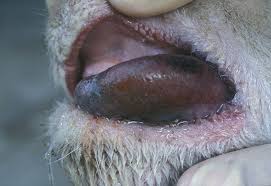Wooden Tongue
Wooden tongue is commonly found in the head of cattle and sheep. It is a disease of the soft tissues of the mouth, mostly in adult cattle and sheep. Wooden tongue infects the host through an open wound or a minor trauma the host may have gone through.

Fact Table on Wooden Tongue:
| Formal binomial name of microbe: | Actinobacillosis |
| Gram stain (gram positive, gram negative or neither): | Negative |
| Is the microbe mobile or immobile? | Immobile |
| Primary habitat? (Where is the organism normally found or prefer to live?) | Head of cattle, sheep, and horses |
| Can the organism infect humans? | No |
| Can the organism infect other species? If so, which ones. | No |
| Documented cases of antimicrobial resistance? | No, viral |
| Number of infections per year in the US | Thousands |
| Number of infections per year in the world | Millions |
Wooden Tongue affects soft tissue in any given place in the gastrointestinal tract. It can cause chronic conditions up to six months after being infected. A main cause of this virus is contamination of soil where cattle/sheep/horses are grazing or weedy hay, which can both be bypassed by ensuring safe grazing/eating places for animals. The symptoms are lack of eating or drinking, swollen tongue, drooling, and ulcers on tongue. Wooden tongue can be treated most effectively up to two weeks after symptoms are noticed. The most effective cure is a mixture of both Penicillin and Streptomycin antibiotics.

Articles About Wooden Tongue:
- An Atypical case of Respiratory Actinobacillous in a Cow
A cow, born and raised in a clinical setting was examined and had nasal discharge, represented a noise similar to snoring, extended head and neck, and giving extra abdominal effort. Wooden tongue can attack the upper respiratory tract. These symptoms all point towards Wooden Tongue. After several examinations and different ways of viewing the cow, it went through surgery and they discovered the cow had Wooden Tongue.
- Wooden Tongue, Lumpy Jaw
This article clarifies different names for different things. The article explains how some names sound confusing and how others are very straight forward. It goes in to further detail explaining that lumpy jaw and wooden tongue are commonly confused for the same thing. Wooden tongue is when the infection spreads to the soft tissue. Lumpy jaw is when the bone of the jaw is infected.
- Diagnosing Lumps and Bumps
This article goes over the importance of checking your cattle for lumps and bumps in general. It is common for cattle to have lumps/bumps on their head and it is also common for them to have wounds in their mouth. The article describes different ways to identify different types of lumps and how to go about treating them.
References:
- Farmhealthonline.com. (2016). Farm Health Online – Animal Health and Welfare Knowledge Hub – Wooden Tongue. [online] Available at: https://www.farmhealthonline.com/US/disease-management/cattle-diseases/wooden-tongue/ [Accessed 18 Jul. 2019].
- Sciencedirect.com. (2012). Actinobacillus lignieresii – an overview | ScienceDirect Topics. [online] Available at: https://www.sciencedirect.com/topics/immunology-and-microbiology/actinobacillus-lignieresii [Accessed 18 Jul. 2019].
- The Cattle Site. (2019). Wooden Tongue (Actinobacillus). [online] Available at: http://www.thecattlesite.com/diseaseinfo/184/wooden-tongue-actinobacillus/ [Accessed 18 Jul. 2019].